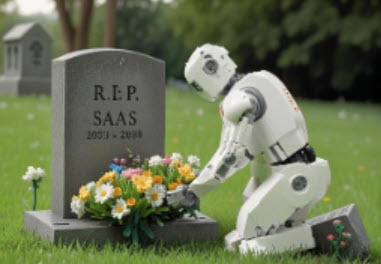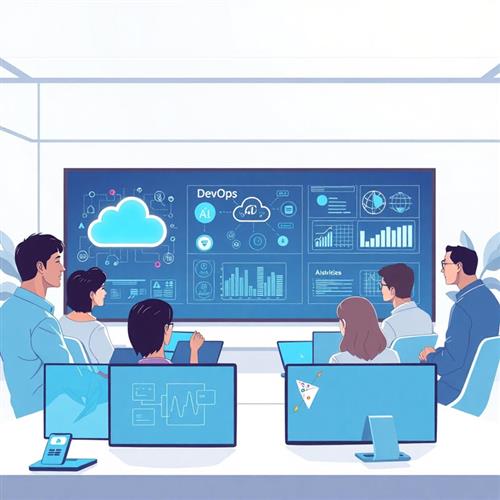
The Decline of Traditional SaaS and the Rise of AI-first Applications
Last updated: January 25, 2025 Read in fullscreen view
- 05 Jul 2020
 What is Sustaining Software Engineering?
What is Sustaining Software Engineering? - 20 Mar 2022
 What is a Multi-Model Database? Pros and Cons?
What is a Multi-Model Database? Pros and Cons? - 21 Dec 2023
 Top 12 Low-Code Platforms To Use in 2024
Top 12 Low-Code Platforms To Use in 2024 - 03 Jul 2022
 What is the difference between Project Proposal and Software Requirements Specification (SRS) in software engineering?
What is the difference between Project Proposal and Software Requirements Specification (SRS) in software engineering? - 22 Sep 2022
 Why is it important to have a “single point of contact (SPoC)” on an IT project?
Why is it important to have a “single point of contact (SPoC)” on an IT project?
The Decline of Traditional SaaS and the Rise of AI-first Applications
1. Shifting Technological Landscape
Artificial Intelligence (AI) is ushering in a new wave of innovation, marked by AI-first applications that are increasingly intelligent, capable of automating numerous processes, and making decisions that often surpass human efficiency in various domains.
Businesses are gradually moving away from traditional SaaS models to adopt AI-driven platforms that offer higher levels of personalization and deeper integration into operational workflows.
2. Limitations of Traditional SaaS
- Low Flexibility: Traditional SaaS solutions generally provide a one-size-fits-all experience, lacking the depth of customization required to address specific business needs.
- High Maintenance Costs: Organizations must continuously pay monthly or annual subscription fees, leading to a rising Total Cost of Ownership (TCO) over time.
- Limited Integration: Although many SaaS platforms offer open APIs, integrating multiple SaaS solutions often remains complex and resource-intensive.
3. AI-native Solutions – The Future of Enterprise Software
- Full Automation with AI: New AI platforms can automate tasks ranging from data entry and analysis to trend forecasting, reducing the dependency on human intervention.
- Generative AI for Personalization: AI technologies deliver highly tailored solutions that adapt to specific business needs, moving beyond the standardized offerings of traditional software.
- AI-as-a-Service (AIaaS): A new model is emerging where businesses can access AI services through APIs with far greater customization capabilities than conventional SaaS.
4. SaaS Evolution: Is It Truly “Dead”?
SaaS is not entirely obsolete but is evolving into AI-driven SaaS, where AI serves as the core enabler, making these platforms smarter, faster, and more responsive to user data.
Traditional SaaS companies must adapt by integrating AI into their offerings to remain competitive. Otherwise, they risk being outpaced by AI-first startups.
The Gray Zone: SaaS vs. AI-driven SaaS
The transition from SaaS to AI-driven SaaS reveals a nuanced gray zone where businesses must evaluate which approach aligns best with their operational goals and technological capabilities. Here are some critical considerations:
Overlap in Use Cases
Both traditional SaaS and AI-driven SaaS serve common business functions, such as Customer Relationship Management (CRM), Enterprise Resource Planning (ERP), and project management. However, AI-driven SaaS adds predictive analytics, automation, and personalization capabilities, offering a competitive edge.
Cost Implications
-
SaaS: Predictable subscription-based pricing but with potentially high long-term costs due to limited scalability and customization.
-
AI-driven SaaS: Higher initial investment in implementation and training but greater ROI through process efficiencies and automation.
Complexity and Integration
-
SaaS: Easier to implement but may struggle with integration across diverse systems.
-
AI-driven SaaS: Requires technical expertise for setup and integration but enables deeper system interconnectivity and adaptability.
Adoption Curve
-
SaaS: More accessible for organizations with limited tech expertise.
-
AI-driven SaaS: Demands a higher level of digital maturity, often involving change management and workforce upskilling.
Future-readiness
AI-driven SaaS is better positioned for future technological trends, such as real-time data-driven decision-making and hyper-personalization, making it an attractive option for forward-looking enterprises.
In this gray zone, businesses must carefully assess their priorities, resource availability, and long-term goals to determine the right approach. While SaaS remains a viable option for companies seeking simplicity and reliability, AI-driven SaaS is emerging as the preferred choice for those aiming to stay ahead in a rapidly evolving digital landscape.
Phạm Đình Trường
Technical Director, TIGO Solutions
















